When Austria declared war on France April 10, 1809, Austrian military strategy called for three independent offensives into adjacent French or French allied territories. Their main army moving into Bavaria under command of Archduke Karl, and two smaller wings advancing into northern Italy (under Archduke Johann) and the recently created Grand Duchy of Warsaw territory tasked to Erzherzog Ferdinand d’Este. Removing the prospect of an independent Poland (aka Duchy of Warsaw) was a cornerstone of Austrian political and military policy after the establishment of the Duchy of Warsaw in 1807, a result of the Tilsit peace conference ending the recent France vs. Russia and Prussia war.
During the short time from Duchy’s foundation and the outbreak of war, the Duchy of Warsaw (DOW) army grew rapidly to cover the expanding demands of Emperor Napoleon. By early 1809, just before the opening of hostilities in April, the DOW regular army stood at twelve infantry regiments (two large battalions each with a third one forming), six cavalry regiments and six raised artillery batteries. Limited in size with little military training, additional local fortress and garrison detachments dotted the Duchy’s territory supporting the newly created DOW army with policing duties. With 37,000 men overall to defend the Duchy of Warsaw, Prince Poniatowski should have sufficient forces to defend the Duchy from the near term Austrian invasion except Napoleon ordered 20,000 of them to other battle theaters as far away as Spain, and locally to garrison Danzig and other Prussian fortresses. This left Poniatowski with a small force of just 15,000 Poles, and a small Saxon brigade, to check a major Austrian advance on Warsaw. Some of the larger detachments from the Duchy’s army are:
5th Infantry regiment [2 btns.] at Kustrin. 10th Infantry regiment [2 btns.] at Danzig and Stettin, 11th Infantry Regiment at Danzig [2 btns.], 4th Chassuers a’ cheval at Stettin, Kustein, Glogau and Stralsund. For Czestochowa garrison the newly raised III battalion [5th Regt.] and 3rd Uhlan detachment with artillery. For French service in Spain, the entire 4th, 7th, and 9th infantry regiments [6 battalions], with a foot 6lb battery, plus the Vistula legion formed from Polish and ex-prisoners of war during 1808.
Stationed in Warsaw, the small Saxon brigade consisted of 1 1/2 converged grenadier battalions, 1st btn. Oebschelwitz I.R., two squadrons of Saxon Hussars, and two batteries of positional 6lb [2×6 cannon] along with two attached battalion cannon (I.R. Oebschelwtz). The converged grenadier battalion came from I.R. Konig and Dyherrn grenadier companies. The smaller grenadier two company detachment solely from the Rechten I.R.
Faced with the task of defending Warsaw and holding the Duchy, Prince Poniatowski mobilized his reduced forces near Warsaw and upon the declaration of war, slowly moved south from Warsaw to defend the excellent marshy stream position near Raszyn. DOW cavalry already positioned ahead and near the Austrian border under GB Rozniecki screened and harassed the slow Austrian cavalry led advance from their army collection point at Odrzygol.
Parade review of the Austrian VII Korps just before it crossed the Polish border shows the following units and organization (per Gil’s Thunder on the Danube Vol III pages 335-7):
VII Korps Main Body: GdK Erzherzog Ferdinand d’Este
7th Pioneer Division (two companies), and various train companies but no bridging or siege artillery trains.
Advance Guard: GM Mohr
I.R. 48 Vukassovich [3 btns 2170], 1st Btn. /1st Siebenburger-Wallach Grenz Nr.16 [1125], 1st Btn. /2nd Siebenburger-Wallach Grenz Nr.17 [1180], Kaiser Hussars Nr.1 [6 sgn. 780], Kavalry battery. 3lb Brigade battery
Division: FML von Monder
Brigade: GM von Pflacher
I.R. 34 Davidovich [3 btns 2450], I.R. 37 Weidenfeld [3 btns 2070], 6lb Brigade battery
Brigade: GM von Trautenberg
I.R. 24 Strauch [3 btns 3290], I.R. 63 Baillet [3 btns 2820], 6lb Brigade battery
Brigade: GM von Civilart
I.R. 30 De Ligne [3 btns 3170], I.R. 41 Kottulinsky [3 btns 3380], 6lb Brigade battery
Division: FML von Schauroth
Brigade: GM von Speth
Somariva Kuirassiers [6 sqn 750], Lothringen Kuirassiers [6 sqn 760], Kavalry battery
Brigade: GM von Geringer
Palatinal Hussars Nr.12 [8 sqn 1020], Szekler Hussars Nr.11 [8 sqn 1130] at Krakow, late to their campaign regimental formation, rode north to join VII Korps at Warsaw after the Raszyn battle.
Artillery Reserve:
2x 12lb Positional batteries, 2x 6lb Positional batteries plus the military train.
In summary: 21,700 infantry, 3,320 cavalry, and 66 cannon and crews at start of campaign.
Ferdinand d’Este detached two squadrons of Kaiser Hussars Nr.1 in March to cover the vast territory of East Galicia as a mobile force in addition to the various small detachments and garrisons dotting the Province of East Galicia under FML Furst Hohenlohe-Ingelfingen. These forces are outlined in Gil’s book, page 336., which also mentions the later (post Raszyn) reinforcements joining VII Korps during the Polish campaign. During the northern pre-campaign march to Odrzgol, Ferdinand d’Este detached an additional small brigade under GM von Branowaczky consisting of the Szekler Grenzer Nr.14 (1st btn.), Szekler Grenzer Nr.15 (1st btn.), Kaiser Chevauleger No.1 (8 sq.), and a 3lb Brigade battery with two extra-attached howitzers to besiege or blockade the small Polish fortress of Czestochowa when the campaign commenced.

Opening campaign movements. This map and others from the excellent internet site Napoleonistyka covering Raszyn 1809 battle. Austrians in red, Polish forces in dark blue.
After collection the components of VII Korps near the small hamlet of Odrzgol on the Austrian border, Erzherzog Ferdinand d’Este set in motion the main Austrian advance towards the Polish border near the riverine town of Nowe Miasto on April 15th. Before this northern march to Odrzgol, GM von Branowaczky and his brigade had already left the main body to prepare for their besiege or blockade the Polish Czestochowa fortress and two squadrons of Kaiser hussars under Major Hoditz were sent across the Vistula River to Okuniew near Praga to observe Polish activity. Ferdinand d’Este quickly learned from Hoditz’s hussars that, with the exception of garrison in Praga and few small detachments, there were no strong Polish forces on Austrian right flank (East Galicia). On Ferdinand d’Este’s left flank, two additional scouting squadrons of Kaiser Hussars, under Major Josef Gatterburg, penetrated as far as Rawa (southwest of Raszyn), reporting limited contract with Polish forces.
The Advance guard under GM Mohr reached the Pilica River outside of Nowe Miasto. After crossing the river and passing through Nowe Miasto, the Austrians continued north towards Tarczyn. Mohr’s Advance guard consists of Palatinal Hussars Nr.12 with six squadrons, two and a partial battalion of the I.R. 48 Vukassovich regiment, and two batteries. Following the Advance Guard, the Main body (FML Mondet’s infantry division and Speth kuirassier brigade) slowly passed through Odrzywol, then Nowe Miasto after crossing the Pilica River, and followed GM Mohr’s path to Tarczyn on April 16 and 17th. Encountering the Polish cavalry screening brigade (GB Rozniecki) before Tarczyn, several cavalry clashes occurred as both sides sought information of their opponent and movements. As his VII Korps marched into Tarczyn to evening bivouac, Ferdinand d’Este found the Polish army remaining elusive and no solid information on Prince Poniatowski’s whereabouts.
Polish reaction…. By now the Duchy forces were gathering along the Mrowa (Rawka) stream position at Raszyn, per orders of Prince Poniatowski. GB Rozniecki’s cavalry brigade well out front and screening the Polish position by their aggressive skirmishing against the Austrian advance. Organizing his battalions and regiments into several brigades to cover the Mwora (Ranka) stream crossings, the Polish command structure shaped out as:
Prince Poniatowski Corps HQ + Engineer officer at Raszyn
1st Chasseurs a’ cheval [730], Saxon Hussars [one sqn. 90], 6lb horse battery, Corps trains. Arriving very late and possible evening reinforcements are 5th Chasseurs a’ cheval [600] and 2nd Btn. /6th Regt [675].
Brigade Bieganski at Michalowice
3rd Regt. [2 btns 1925], 6lb foot battery.
Brigade Kamienski at Jaworow
2nd Btn. /1st Regt [825], 2nd Btn. /8th Regt [750], 2nd Uhlans [one sqn 200], 6lb foot battery.
Saxon Brigade Dyherrn (von Polentz) at Raszyn
DOW 2nd Regt [2 btns 1750], Grenadier Btn. von Einsiedel, Grenadier Btn. von Rechten, 1st Btn. / I.R. Oebschelwitz, 2x 6lb Positional batteries.
Brigade Sokolnicki at Falenty
1st Btn. /1st Regt, [825] 1st Btn. /6th Regt [675[, 1st Btn. /8th Regt. [750], 6lb foot battery.
Cavalry Brigade Rozniecki screening the Polish army out front
2nd Uhlans [600], 3rd Uhlans [760], 6th Uhlans [700], 6lb Horse battery.
During April 18th, Ferdinand d’Este made minor changes to his command structure. The Kaiser Hussars, rejoined by their detached 2 squadrons under Major Gatterburg from Rawa, along with a partial battalion of I.R. Vukassovich [four companies of 3rd btn.], two squadrons of the Palatinal Hussars, and a kavalry battery, were placed under GM Geringer’s command and ordered to secure the left flank of the Austrian advance that day. FML von Schauroth joining GM Geringer for the left flank march via Nadarzyn to enter the Raszyn battlefield near Wolica. The rest of the Palatinal Hussar Nr.12 [5 sqn.] reinforced the Advance guard under GM Mohr, in effect swapping places with the Kaiser Hussars Nr.1 who skirmished and led the prior days of Austrian advance. The last squadron of Palatinal Hussars Nr.12 remained detached under Major Szilly’s command continued their scouting along the Vistula River and covering the far Austrian right during the battle to come.
This leads to the first of several interesting points about this documented battle… the location of the Kaiser Hussars (8 squadrons). The accounts WR read has only a squadron or two with GM Geringer’s brigade out on the left flank (Gil’s book), no mention about being with the Advance guard under GM Mohr, GM Speth’s kuirassiers, or the Austrian Main body of infantry. Known that two squadrons are in East Galicia with Major Hoditz, maybe two with GM Geringer…. so where is the rest of the regiment? The Napoleonistyka site mentions “two” hussar regiments with GM Geringer… not two squadrons. Palatinal Hussars Nr.12 for one… the other being Kaiser Hussars Nr.1? For his Raszyn scenario WR placed all the available Kaiser Hussars under GM Geringer’s (FML Schauroth) left flank brigade, advancing towards Wolica, pushing the Polish screening cavalry back towards Janki, in conjunction with GM Mohr’s Advance guard. If only the two squadrons of Palatinal Hussars were present with GM Geringer… why would the Polish 3rd and 6th Uhlan regiments (GB Rozniecki) be forced to retire before they saw the appearance of GM Speth’s kuirassier brigade exiting from the Lazy village woods? Lastly… why place FML Schauroth in command of only two hussar squadrons and partial battalion of I.R. 48 Vukassovich. His rank and presence indicates a larger force, especially since he is commanding the cavalry of VII Korps during past week’s general advance into the Duchy.
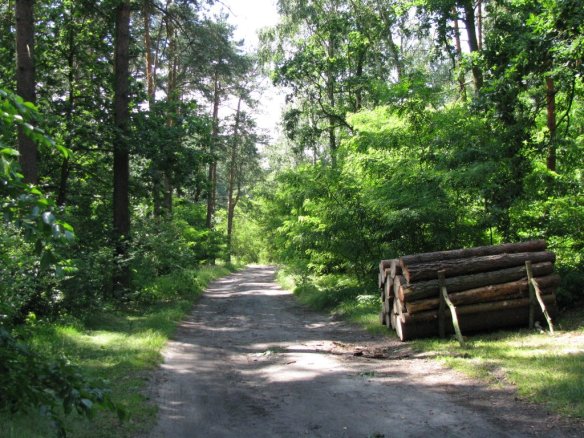
A roadway through the woods near present day Lazy. Other than the ground being dry, the Austrian army marched through Polish woods like this modern-day photo. Photo by Rutra 14.
Placement of the Palatinal Hussars seems to have some confusion for the second point of interest. Several accounts place the Palatinal Hussars “main body” (5 1/2 sqns) with the arrival of Ferdinand d’Este and the GM Speth kuirassier brigade along the Tarczyn to Raszyn road, passing through the village of Lazy at the woods exit. If so, the remaining available 1 1/2 squadrons rode with the Advance guard under GM Mohr using the Tarczyn to Janczewice road (remaining single sqn. detached under von Szilly along the Vistula River), leading to the question, why such a small force of cavalry for the Advance guard? This same Advance guard, which for the last few days has been pushing back the screening Polish cavalry brigade (GB Rozniecki). Doesn’t add up…. but if the Napoleonistyka site is studied, using some Polish sources, the “Main body” of the Palatinal Hussars (5 1/2 sqns.) split into two groups, Two squadrons went over to GM Geringer (FML Schauroth) on the left flank via the Lazy village road, and the rest rode with GM Mohr and headed his advance, pushing back the DOW 2nd Uhlans. WR used this line of thought for his scenario as the other method has 1 1/2 squadrons of Palatinal Hussar vs. the 2nd Uhlans (a larger formation), somehow pushing the Polish cavalry back past the Wygota Inn and allowing the Advance guard to deploy beyond Janczewice.
Arrival of the GM Speth’s kuirassiers is the third point for discussion. Accounts state the kuirassier brigade, along with Ferdinand d’Este and the Palatinal Hussars, advanced through the woods from Tarczyn towards the village of Lazy, which lies between Wolica and Janczewice, heading for the Janki to Raszyn road. In that position they formed a link between the left flank under GM Geringer and the Main body advancing on Janczewice. The afore-mentioned woods covered the advance of the Austrian army towards Raszyn. Each of the wood road exit villages… Wolica, Lazy, and Janczewice created problem and delay for the Austrian advance towards Raszyn, factoring in poor weather and roadway conditions. Appearing at Lazy village, the presence of the kuirassier brigade supported GM Geringer’s advance out of Wolica, after the Polish cavalry retired towards Michalowice. Did they stay forward of Lazy village and support GM Geringer’s later advance towards Wypedy /Janki villages or, upon leaving Lazy road exit, the kuirassiers rode northeast towards the Main body approaching Wygota Inn on the Janczewice to Falenty to Raszyn road? Per Gil’s account, the kuirassiers crossed the mentioned roadway and supported the advance towards Jaworow late in the day, including slow going in the marshy ground south of Jaworow just like the Palatinal Hussars.

Saxon Hussars with their earlier pre-1810 uniform used in the Polish campaign. In 1810 their uniform changed towards the French shako style.
Fourth point of interest. The Saxon Hussars and the detachment from the 2nd Uhlans on the Polish left flank confusion. Looking at the accounts and maps from Gil’s book and Napoleonstyka site, the two don’t match. Gil’s text positions one Saxon sqn. on the low hill near Raszyn and the other squadron on detachment duty covering the Polish right flank near Blonie, along with the elite company from the 5th Chasseurs a’ cheval regiment. The 2nd Uhlans starts near the Wygoda Inn, in front of GM Mohr’s advance along the Janczewice to Raszyn roadway. The remaining third squadron covers the open Polish left flank near Dawidy. Napoleonstyka and their Polish sources place the Saxon squadron on the Raszyn hill, the detachment on the Polish left flank near Dawidy and Jeziorki and no mention of the third 2nd Uhlan squadron’s position. Looking with common military sense and the map… the Polish left flank cavalry detachment should be the 2nd Uhlan detachment and not the Saxon hussar detached sqn. Having the 2nd Uhlans near Wygoda Inn allows for the 2nd Uhlan commander to oversee and command the nearby detachment near Dawidy village and accounts for the missing squadron unmentioned by Napoleonstyka’s account of the battle.

From the SYW period, the Austrian bridging train, like many other nations, didn’t change much except for the uniforms into the napoleonic period. See DAF link below for more period prints.
Austrian SYW Bridging train link from Der Alte Fritz’s Journal. Fifth point of interest is the lack of bridging equipment or train and any siege artillery attached to VII Korps. With wooden bridges spanning the major roads of Poland, if the Polish army damaged or destroyed (burned) those bridges, the Austrian advance would have been seriously delayed pending formal bridge construction. Despite this simple tenant of war the Austrian korps had no bridging train assigned to the korps headquarters column. There were several fortresses in the Duchy, yet the Austrians had no siege artillery to besiege or assist in storming. Lacking these trains, the Austrian later in the campaign became hampered in their capabilities, leading to several rash decisions near Warsaw and Praga.

Opening movements and the cavalry encounters during Austrian advance and deployment. Napoleonstyka site.
With the Austrian deploying from the wood line at Wolica, Lazy, and Janczewice, the screening Polish cavalry brigade under GB Rozniecki retired back to two split locations. The 2nd Uhlans besides the Wygoda Inn on the Janczewice to Falenty road, and the 3rd and 6th Uhlans before the village of Janki. Several sharp engagements issued between the advancing Austrians and the Polish uhlans. As more Austrian cavalry appeared from the wood line, especially the kuirassier brigade near Lazy village, the Polish cavalry was ordered by Prince Poniatowski to retire across the Mrowa (Rawka) stream via Michalowice or Falenty then Raszyn for the 2nd Uhlans. By midday the Austrian cavalry and GM Mohr’s Advance guard controls the entry to the battlefield from the south. Summoned by GM Mohr’s message received at Lazy, the arrival of Ferdinand d’Este (via Lazy road) just after midday gave a surprise to Ferdinand. GM Mohr’s message made no mention of the presence of Polish infantry. So after watching the Austrian advance guard cavalry brush back the screening Polish cavalry (2nd Uhlans), Ferdinand d’Este could finally see the entire DOW army deployed before him, positioned along the Mwora (Rawka) stream line and forward Falenty village. Reacting with atypical Hapsburg speed, a flurry of orders sent from Austrian headquarters set in motion the battlefield events of the afternoon.
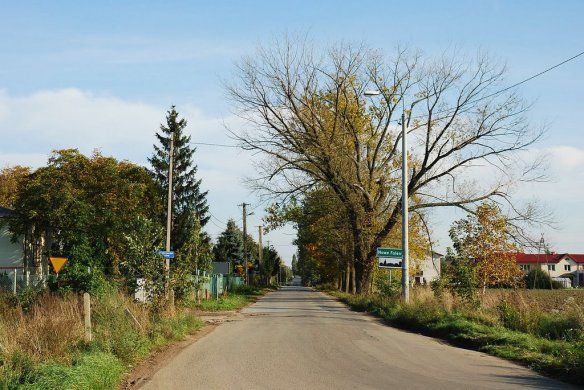
Road into the outskirts of Falenty from Wygota Inn position. I.R. 48 Vukassovich generally followed this road into Falenty several times during the battle.
Issuing orders from near the Wygota Inn, the afternoon battle started with the Austrian Advance guard marching forward to Falenty except for the Palatinal Hussars towards Jaworow. GM Civilart’s brigade, assisted by GM Pflacher’s brigade, to attack towards Jaworow, seizing control of the Mrowa (Rawka) stream crossing there. The flank marching two Grenz battalions to cross near Dawidy and secure the far right flank advance. Left flank GM Geringer and FML Schauroth secured the open ground left flank, generally following up the retiring Polish uhlan cavalry towards Janki village during the early afternoon. GM Speth’s kuirassier brigade, along with GM Trautenberg’s infantry brigade to form the reserve near Wygota Inn. All these movement took some time and it was 3pm in the afternoon before the first pressed assaults took place.
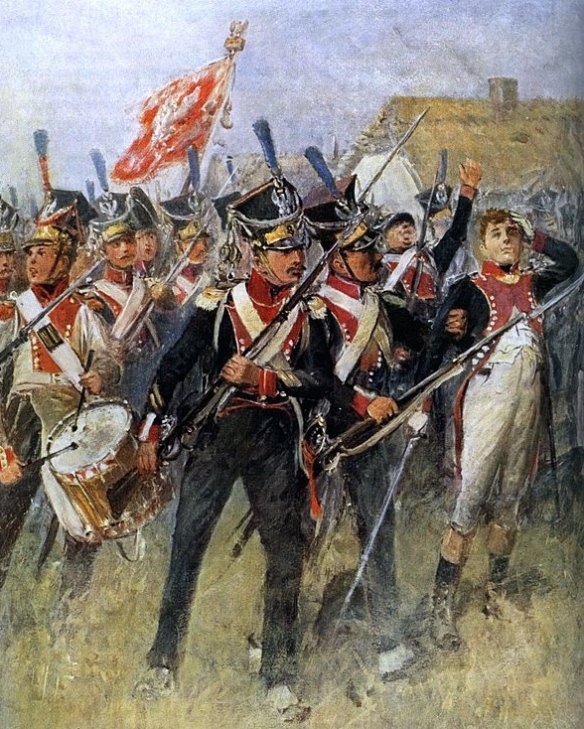
Polish infantry near Falenty village. Based upon the unit facing, these Polish infantry could be 6th or 8th Regiment. The white coat drummer is interesting difference from the fusiliers.
Unopposed, the two Wallach grenz battalions soon completed their task, crossing the Mrowa (Ranka) stream on a small foot bridge into Dawidy. Thereafter their remaining battle involvement was limited to skirmishing with the Polish infantry at Jaworow. The I.R. 48 Vukassovich regiment soon found the defenders of Falenty a tough opposition. Connected to Raszyn by a narrow marsh causeway, the position at Falentry was like a forward redoubt for the DOW army, partially fortified by the Polish defenders that morning. Two Polish battalions held Falentry (1st btn. /1st) and the alder woods just south of the village (1st btn./ 8th) supported by a foot battery. The last battalion of GB Sokolnick’s brigade (1st btn./6th) held Janki Inn on the road from Janki to Raszyn, facing off against the slow advance of FML Schauroth’s small flank mixed command during the mid afternoon. Back at Falenty the Hapsburg infantry, receiving Polish artillery fire during their advance, stormed into the small alder woods. Close savage combat tested the Polish and Hapsburg infantry, slowly the 2nd btn./8th battalion was pushed backwards towards Falenty. Seeing the stressed Polish battalion, Prince Poniatowski rode up with his staff and, leading the nearby 1st btn/1st regiment in counterattack, forced I.R. Vukassovich to recoil, but quickly rallied back near their starting position.
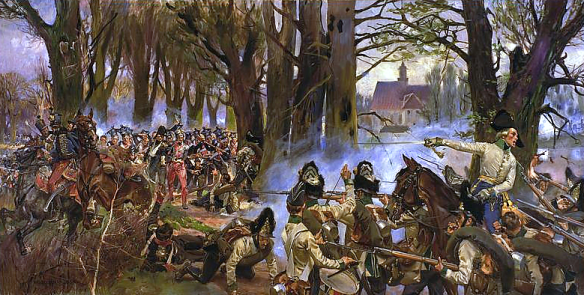
Polish counterattack led by Prince Pontiatowski himself with staff, leading the 1st regiment infantry, against the attacking I.R. 48 Vukassovich regiment. Note the Austrian grenadier companies not present that day. Painting by W. Kossak.
Seeing FML Schauroth’s small command near Janki, Ferdinand d’Este sends an officer to Janki with orders for a converging assault with Mohr’s brigade and the infantry under FML Schauroth (I.R. Vukassovich battalions). Seeing the Polish 1st btn./6th regiment battalion retire to cover the causeway end near Raszyn crossing, the two Hapsburg commands converged on the Falenty defenders, starting with the alder woods again, then the village itself. Supported by three batteries of Hapsburg artillery, the Hapsburg infantry stormed into the woods or village. Fighting desperately from woods or buildings, the Polish infantry held their ground till the foot battery retired along the causeway back into Raszyn. GB Sokolnicki’s infantry maintained their cohesion, retiring over the causeway and eventually into Raszyn village across the Mrowa (Rawka) stream bridge. Time ticks past 5pm on the battlefield.

Old Polish postcard from the 100th anniversary of Raszyn battle. Shows the causeway toward Raszyn in distant background.
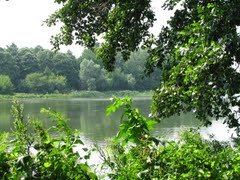
Marshy ground near the Falenty causeway towards Raszyn. The post battle “fish ponds” came about after the battle later in the 19th century.
Before proceeding to the action at Raszyn during the evening light, a discussion of the Hapsburg attempts at Jaworow. Ferdinand d’Este’s main attack had run into trouble. Sending the Palatinal Hussars ahead, they quickly found the sodden, marshy area near the Mrowa (Rawka) stream unfit to cross after chasing away the 2nd Uhlan remnant. Well sighted Polish foot artillery increased the hussar’s discomfort crossing the foundering terrain. After loss of troopers and time, the hussars extricated themselves from the ill suitable ground and retired. The Somariva Kuirassiers, following to support the initial Palatinal Hussar effort, likewise found themselves in the same ill suitable cavalry terrain. Quickly they joined the hussars in post-haste retirement. Finally an Austrian kavalry battery was summoned to drive away the isolated Polish foot battery, which allowed the reformed Palatinal Hussars to finally reach the southern bank of the Mrowa (Ranka) stream near 4pm. Once there, they quickly discovered the Polish infantry had removed bridge planking for the only crossing point near Jaworow village.
Following the Hapsburg cavalry GM Civilart’s infantry brigade was equally confounded by the difficult terrain. Soon their effort dissolved into a time-consuming search for bridging materials while the unlimbered Polish foot battery sent round shot across the stream. GM Pflacher’s infantry, following the path of GM Civilart’s battalions, merely ended up waiting in position south of the Mrowa (Rawka) stream, just standing about in the muddy meadows. For reasons unknown to WR, the ability for crossing the Dawidy foot bridge was never ordered or attempted, even after seeing the grenzers skirmishing across the stream near Jaworow village. The end result… a big nothing, mainly from the lack of Austrian aggressive commanders seeking other crossing points or really trying to cross the deep stream at several points to stretch the two battalion Polish defense.
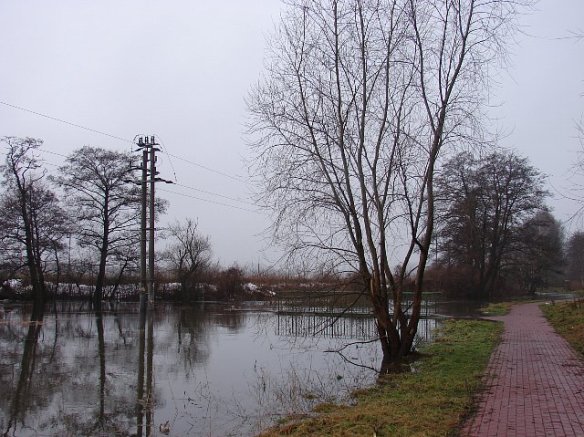
Same Mrowa (Rawka) stream at different nearby location, but at high water level after recent heavy rainfall. Before the battle the rains early campaign raised the water level.
Evening battle of Raszyn started about 6pm and lasted into the night hours. After clearing the Falenty forward position and crossing the causeway, the Advance guard brigade under GM Mohr pressed towards the Raszyn bridge. Behind them FML Schauroth (GM Geringer) small mixed command backed up their forward movement via the road from Janki village. Crossing the bridge, the Austrian infantry entered Raszyn for a brief moment. Under directed Saxon artillery fire from the low-rise, and soon counterattacked by Polish and Saxon battalions, the Hapsburg infantry retreated from the Raszyn village. Ferdinand d’Este, unaware of the Austrian repulse at Raszyn, was expecting a successful outcome at Raszyn. Sending Hauptmann Renner from his staff to investigate, Renner quickly realize the situation required reinforcements. Summoning several battalions from GM Pflacher’s stationary brigade (I.R. Weidenfeld), the Hapsburg advance resumed into Raszyn during the evening hours, especially after 7pm. After taking the strongpoint church near the bridge, the Austrian advance slowly eroded the Polish and Saxon battalion defenses northward till the village was cleared by 9pm. Prince Poniatowski, after a council of war at 10pm, ordered a general retirement north towards Warsaw with his corps. The battle of Raszyn was over.
A more complete and details history of the Raszyn battle is recommend reading in Gil’s 1809 Thunder on the Danube Volume III [pages 11-20].
The WR scenario attempt comes about trying to integrate the major issues and flow of the battle. With the larger force available to the Austrians the battle on a common open terrain tabletop scenario would be a walk over Austrian victory. Delaying the Austrian brigade arrival helps a bit but still the small Polish army would be hard pressed to defend the length of the Mwora (Rawka) stream. It was possible to cross…. just needed the commanders to try… like any all-knowing wargamer would. Other points of concern is why the larger Austrian artillery seemed to have little effect on the battle, except for the final assault on Falentry village. Massed Austrian batteries would clear a path over the Mrowa (Rawka) stream quickly, driving the Polish infantry away from the stream bank. So, the battle terrain required a closer look, especially why would an Austrian player ride his cavalry into a bog, and the planking removed from the Jaworow bridge.
The Austrian positional artillery problem was easy to fix…. it arrives at the tail end of all the infantry brigades. By the time it arrives to set up across the Mrowa (Rawka) stream the Austrians would have lost the battle most likely with the remaining hours of scenario game time. Also, reading the historical accounts, the Mrowa (Rawka) stream bed and nearby ground was mentioned with tress and undergrowth. For the scenario, bombardment capability is range restricted when firing across the stream line, unless the target or firing battery is on the low-rise near Raszyn.
The removed planking of the Jaworow bridge effectively stopped the Austrian right flank advance from GM Civilart’s historical point of view. His infantry tried half-heartily to cross the stream near the dismantled bridge but the nearby Polish infantry and foot battery made short work of any organized effort. For the scenario, the bridge is without the planking but for fun WR used his event card game design feature to play the “bridge planking” into the scenario. For the Dawidy foot bridge, only infantry can cross thus removing the wise tabletop Austrian player from trotting across with his cavalry early in the scenario. Still, the Austrian players can simple spread out along the Mrowa (Rawka) stream and attempt crossing at many locations…. will take time and not certain in any way because of the d6 scenario rule roll required to just “think of attempting” the crossing. Overall, the three bridges and footbridge are the preferred infantry crossing points, required for any cavalry or artillery battery movement over the stream.
Likewise, an event card handled the “cavalry in the bog” historical event situation. Giving the Polish player an opportunity to “bog the cavalry” after an Austrian movement phase was amusing. Simply, the Austrian cavalry is moved during their movement phase, then the Polish player can elect to play the event card once and place a 6″ rounded “march terrain” directly centered under the Austrian cavalry miniature formation, if that location is within 12″ of any tabletop marshy terrain already deployed. To exit the marshy/ bog like ground, the cavalry must dismount, walk out of the terrain, then remount again …. effectively removing the trapped cavalry regiment (or several) for several game turns. Creates the surprise and effect nicely.
Proved to be a fun scenario after a few minor adjustments. Comments always welcome. The full scenario notes (.doc) file with; scenario detail, forces or OOB, weather, terrain effect, scenario map, starting locations, orders, reinforcement schedule, and victory conditions: Raszyn 1809 Scenario notes
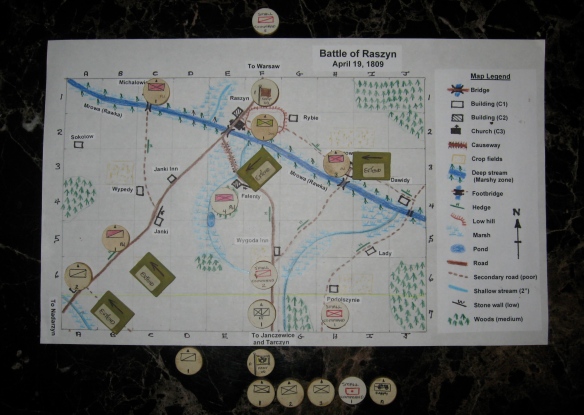
Raszyn 1809 scenario map. Details found in the Raszyn scenario notes (.doc) file linked in this blog post.
For Raszyn and other 1809 battles, one must check out Peter Anderson’s Blunders on the Danube scenario book (recommended) and his blog under same name. Otherwise the sources for WR’s Raszyn 1809 scenario include these books, especially Gil’s Thunder on the Danube Vol III, the internet Napoleonslyka Raszyn site, and a recent Polish paperback book called Raszyn 1809.
A complete Raszyn 28mm miniature scenario AAR can be read at Raszyn 1809 AAR. This scenario AAR was played several weeks ago to test the Raszyn 1809 scenario design notes. Minor corrections or changes for the Austrian reinforcement schedule and Palatinal Hussar assignment (of squadrons) have been done from the play test results, in particular the late arrival of the Austrian reserve batteries and Palatinal Hussars squadron split between GM Mohr and GM Geringer’s brigades.
Cheers from the warren.
WR
P.S. Photos posted of the 2006 reenactment held on the battlefield just east and outside of Falenty village.


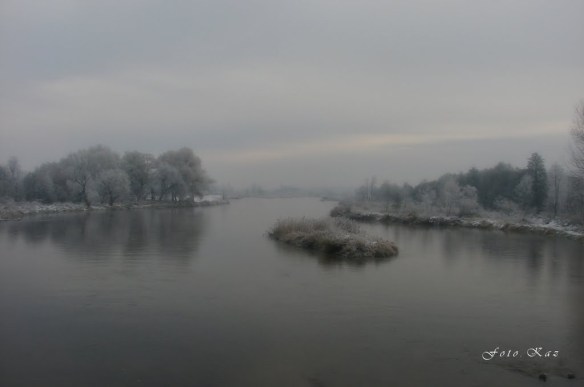
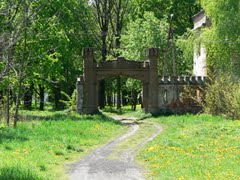


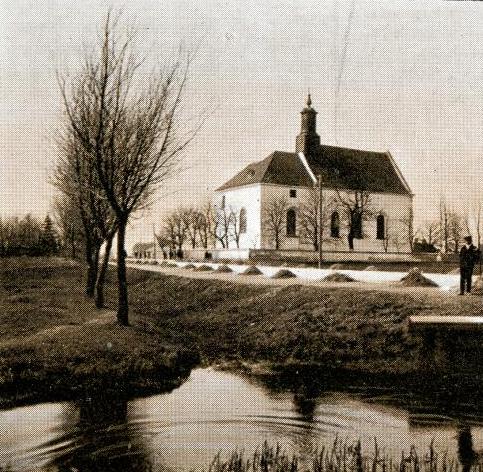
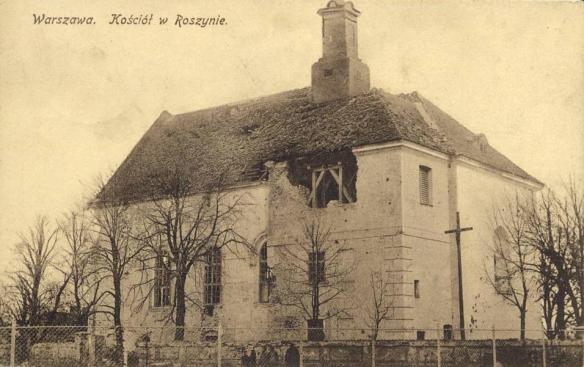


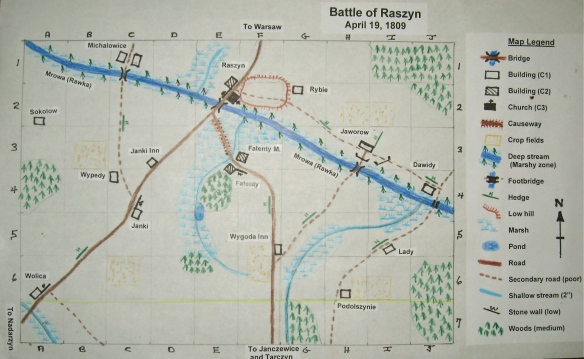


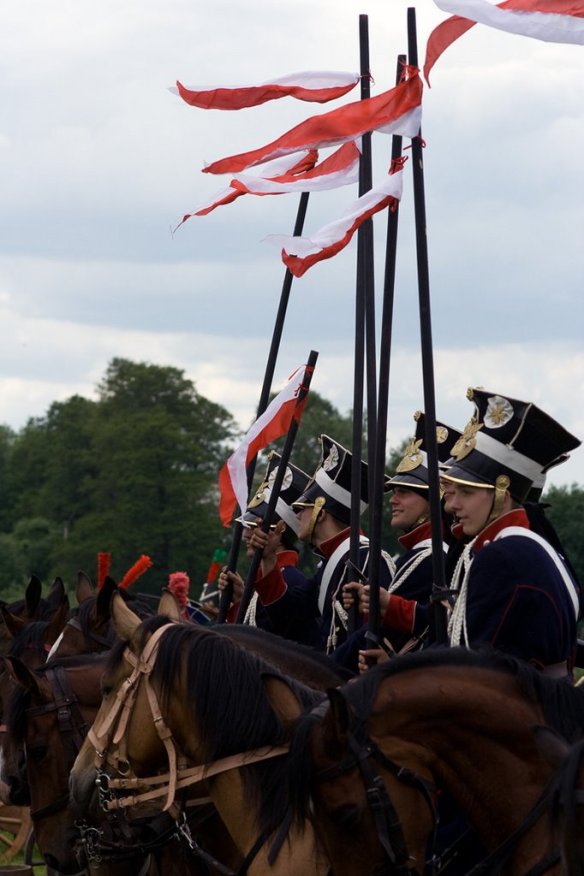



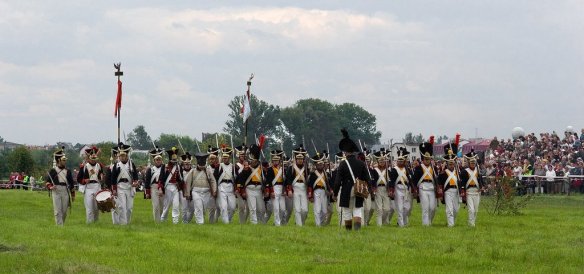
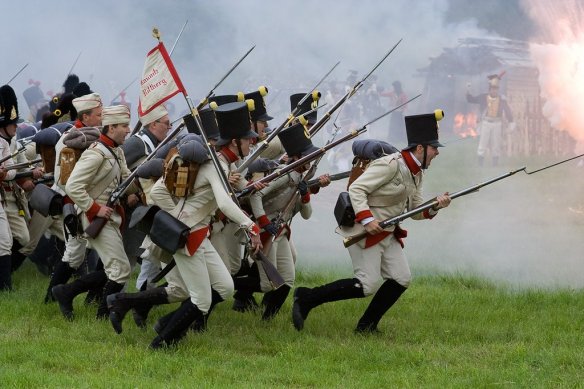

just catching up to your bog posts of the past month – this one is really great stuff!
Thanks Peter. Scenario played well and basically to the historical time line.
M
Not wishing to start colonising your blog, but the mention of the (lack of ) bridging equipment reminded me of this beautiful 25/28mm (sadly I’m working in 15/18mm myself) offering, posted to TMP earlier this year: http://www.schilling-figuren.de/product_info.php?products_id=873&XTCsid=87era0lov7rk2froqu9ah40sc2
Cheers,
John